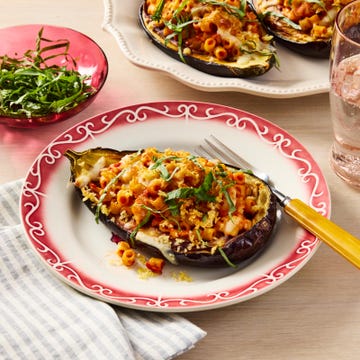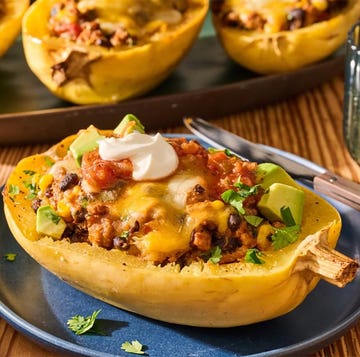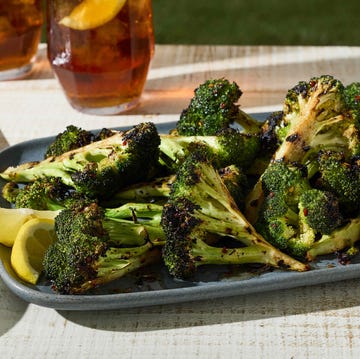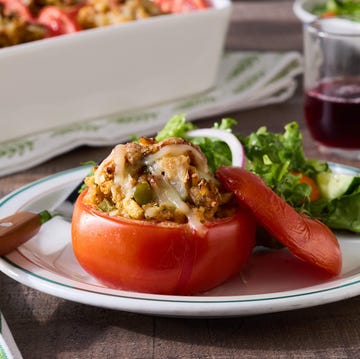1Carrots
 MarkSkalny
MarkSkalnyFor home cooks, this is one of the handiest things you can grow. Before you sow your seeds, rake the soil to make sure it's loose and then plant seeds where you plan to keep the carrots growing the whole time. These babies don't transfer well, so they'll need to stay put. You may want to grow giant carrots, but keep in mind that the smaller the carrot, the better the flavor. One major pro of carrots is that if you leave them over the winter, they'll flower the next year— which means free seeds.
Sun: Full to partial
Soil: Loose and sandy
2Radishes
 Tim Platt
Tim PlattRadishes are great starter root veggies because they're actually very easy to grow from seed. Plus, if you're the impatient type (no judgment), you'll be able to see the result of your labor in a short time, since radishes are ready for harvest less than a month after planting. Because they're such quick studies, keep planting seeds in batches to keep radishes rolling all summer. But also make sure to keep an eye on them. They mature fast and once radishes are past their prime, they're not as tasty.
Sun: Full to partial
Soil: Well-drained with average fertility
Advertisement - Continue Reading Below
3Parsnips
 duckycards
duckycardsCarrots' starchier cousin, parsnips, thrive with a little adversity, so plant them in the spring a few weeks before the weather changes. If they go through a few light frosts, they'll actually taste better come harvest. Parsnips are kind of the opposite of radishes in that they take a long time to fully grow. If you're hoping to work some parsnips into your Thanksgiving stuffing, you'll need to start them out in early spring.
Sun: Full
Soil: Well-drained
4Onions
 Seb Oliver
Seb OliverOnions fall under the "bulb" category of root plants along with their friend garlic (we'll get to that later). Onions need a bit of elevation, so plant them in raised beds with the soil mounded at least four inches or higher. They're very difficult to grow from seed, so we suggest buying them as seedlings and growing them from that point. One major pro to growing onions is that they appreciate cool weather, so you can plant them early in spring. It's good for them to experience temperature drops early in their growth.
Sun: Full
Soil: Loose and nitrogen-rich
Advertisement - Continue Reading Below
5Beets
 Getty Images
Getty ImagesJust beet it! We love beets because they're another plant that's fairly easy to grow, plus they yield edible leaves and roots. Plant beets in early spring so they can get plenty of sun, because the best color and flavor actually comes from that sunlight, plus cooler weather. Keep an eye on them to weed out competitive plants that might lead to weaker roots, and make sure they're regularly watered for the best final product.
Sun: Full
Soil: Average
6Turnips
 Mint Images
Mint ImagesTurnips taste like a cross between a radish and a cabbage: They're bitter and crisp (and taste great in dishes like Turnip Gratin). The leaves and roots of turnips are both edible, so this is another bang for your buck crop. The thing with turnips is that they don't thrive in heat, so you'll want to sow them in late summer and let them grow through the fall when temperatures cool down. The flavor of turnips is actually improved if they experience light frost.
Sun: Full
Soil: Well-drained and loose
Advertisement - Continue Reading Below
7Horseradish
 dulezidar
dulezidarHorseradish packs robust flavor, so it's no surprise that the plant itself is strong too. One of the few plants without pest or disease problems, this root does best planted in spring. Just note that horseradish spreads quickly and can take over other plants you might be growing, so you'll need to keep a close watch to avoid garden domination. For even bigger flavor, remove the top leaves; the roots will grow bigger and taste hotter. Most people will get what they need out of only two or three plants.
Sun: Full
Soil: Rich and well-drained
8Celery Root
 Mariha-kitchen
Mariha-kitchenAnother plant for the patient, celery root takes three weeks or more to germinate. The good news is that it doesn't need daily watering, so you can plant it in early spring and then forget about it for bit if you're in an area that experiences fairly regular rain. The spacing of the plants will determine how big they grow, so keep 18 inches between each for larger roots and 15 inches or less for smaller ones.
Sun: Full
Soil: Fertile
Advertisement - Continue Reading Below
9Potatoes
 Sanny11
Sanny11Potatoes aren't super tricky too grow, but they do require a bit of know-how. You'll need to plant them in hilled rows, which means you'd first dig out little trenches then cover the plant in a few inches of soil to get it started. Without hilling them, or creating these little mounds of soil on top, potatoes will turn out bitter. They're a cool-weather plant, so they work great as a winter crop in warm climates and are perfect for spring planting before the last frost in colder weather. Harvest them early when small for "new potatoes" with soft skin.
Sun: Full
Soil: Cool, well-drained and sandy
10Sweet Potatoes
 Westend61
Westend61Sweet potatoes need very fertile soil and to be watered deeply during droughts or dry periods. Just like their potato brethren, they need loose soil so that their tubers (enlarged roots) have space to spread out. They're also a bit trickier to plant because they need to be propagated by planting slips, which are little shoots grown from mature potatoes (you can buy these online or from a garden center). This planting admittedly takes a bit more skill than the average vegetable, but yields some delicious results.
Sun: Full
Soil: Well drained and fertile
Advertisement - Continue Reading Below
11Rutabagas
 BSPollard
BSPollardRutabagas are a cross between turnips and cabbage and taste a bit bitter when raw, but have a tasty sweet-savory note when cooked. Plant this late-harvest crop in the summer and pick your bounty in autumn: This is another plant that also tastes better after a few frosts. Make sure they get space (about 8 inches between each plant) so that roots can grow fully.
Sun: Full
Soil: Loamy
12Garlic
 sissy_12
sissy_12This plant is a home run because it's easy to grow and something many home cooks use all the time. Luckily, you can plant garlic in both the spring and fall so you can keep reaping the rewards. Garlic grows best in raised beds (weed-free areas where water can drain) and takes a while to reach its peak: eight months or so.
Sun: Full
Soil: Well-drained with no standing water

Erica Finamore is the Features Editor at Food Network Magazine and The Pioneer Woman Magazine, covering home décor, shopping and entertaining. You can follow her on Instagram @Decorofthematter
Advertisement - Continue Reading Below
Advertisement - Continue Reading Below
Advertisement - Continue Reading Below


























